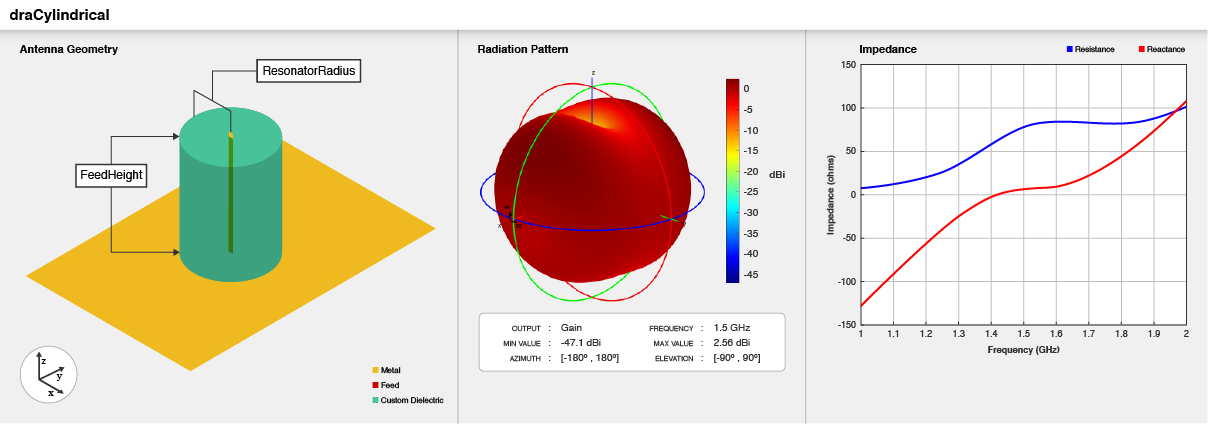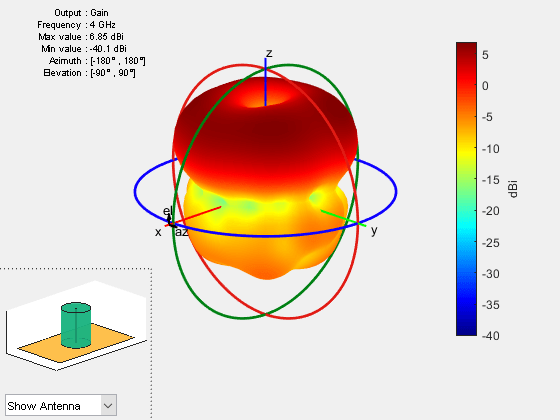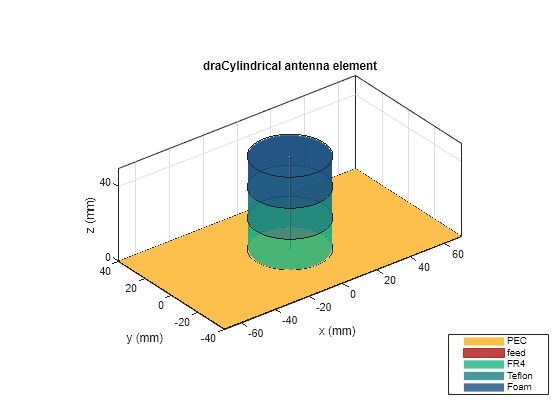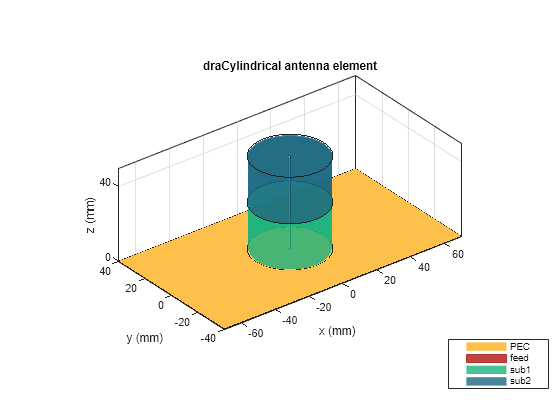draCylindrical
Description
The default draCylindrical object creates a cylindrical
dielectric resonator antenna resonating around 4.9 GHz. The cylindrical dielectric resonator
antenna consists of a cylindrical dielectric placed on the ground plane. It has high
power-handling capacity and can provide high gain and bandwidth. These antennas are more
suitable for use at microwave frequencies. Cylindrical dielectric resonator antennas are
widely used in medium- and long-range communications.

Creation
Description
dc = draCylindrical
dc = draCylindrical(Name=Value)Name is the property name and
Value is the corresponding value. You can specify several
name-value arguments in any order as Name1=Value1,...,NameN=ValueN.
Properties that you do not specify, retain their default values.
For example, dc = draCylindrical(ResonatorRadius=0.04) creates a
cylindrical dielectric resonator antenna with radius of the dielectric resonator set to
40 mm. and default values for other properties.
Properties
Object Functions
axialRatio | Calculate and plot axial ratio of antenna or array |
bandwidth | Calculate and plot absolute bandwidth of antenna or array |
beamwidth | Beamwidth of antenna |
charge | Charge distribution on antenna or array surface |
current | Current distribution on antenna or array surface |
design | Design prototype antenna or arrays for resonance around specified frequency or create AI-based antenna from antenna catalog objects |
efficiency | Calculate and plot radiation efficiency of antenna or array |
EHfields | Electric and magnetic fields of antennas or embedded electric and magnetic fields of antenna element in arrays |
feedCurrent | Calculate current at feed for antenna or array |
impedance | Calculate and plot input impedance of antenna or scan impedance of array |
info | Display information about antenna, array, or platform |
memoryEstimate | Estimate memory required to solve antenna or array mesh |
mesh | Mesh properties of metal, dielectric antenna, or array structure |
meshconfig | Change meshing mode of antenna, array, custom antenna, custom array, or custom geometry |
msiwrite | Write antenna or array analysis data to MSI planet file |
optimize | Optimize antenna or array using SADEA optimizer |
pattern | Plot radiation pattern and phase of antenna or array or embedded pattern of antenna element in array |
patternAzimuth | Azimuth plane radiation pattern of antenna or array |
patternElevation | Elevation plane radiation pattern of antenna or array |
peakRadiation | Calculate and mark maximum radiation points of antenna or array on radiation pattern |
rcs | Calculate and plot monostatic and bistatic radar cross section (RCS) of platform, antenna, or array |
resonantFrequency | Calculate and plot resonant frequency of antenna |
returnLoss | Calculate and plot return loss of antenna or scan return loss of array |
show | Display antenna, array structures, shapes, or platform |
sparameters | Calculate S-parameters for antenna or array |
stlwrite | Write mesh information to STL file |
vswr | Calculate and plot voltage standing wave ratio (VSWR) of antenna or array element |
Examples
More About
References
[1] Keyrouz, S., and D. Caratelli. “Dielectric Resonator Antennas: Basic Concepts, Design Guidelines, and Recent Developments at Millimeter-Wave Frequencies.” International Journal of Antennas and Propagation 2016 (2016): 1–20.
Version History
Introduced in R2021a




